Synthesis and Biological Studies of New Temporin A Analogs Containing Unnatural Amino Acids in Position 7
Abstract
:1. Introduction
- According to their origin, AMPs are divided into four groups—mammalian, amphibian, microorganism-derived, and insect-derived. Representatives of the first group include defensins, cathelicidins, and lactoferricin B. A significant part of the amphibian defense against pathogens is provided by own-produced AMPs [9]. The well-known first group magainins are isolated from frogs [10]. Microorganisms such as bacteria and fungi can also yield antimicrobial peptides. Notable examples of such peptides include nisin and gramicidin, which are synthesized by Bacillus subtilis, Lactococcus lactis, and Bacillus brevis strains. The strong ability of insects to adapt is largely due to AMPs, which are primarily synthesized in their blood cells and fat bodies. Found in bees, guppy silkworms, and Drosophila, cecropins are the most well-known family of AMPs found in insects [8,11];
- According to their activity—an overview of the activities of AMPs includes peptides with antibacterial, antifungal, antiviral, antiparasitic, and antitumor activities. Antibacterial peptides are a significant part of AMPs and have a comprehensive inhibitory activity against many pathogenic bacteria. Many AMPs such as nisin, defensins, and cecropins have demonstrated good inhibition of Gram-positive and Gram-negative bacteria. Antifungal peptides, a subclass of AMPs, target fungal infections with an increased resistance to drugs. Examples of such peptides include brevinine, cecropin, and ranatuerin. Antiviral peptides are also an important class of AMPs that show a potent killing effect on viruses. Antiparasitic peptides have the ability to eradicate parasites responsible for diseases like malaria and leishmaniasis. Anticancer peptides demonstrate their antiproliferative effects by enlisting immune cells to destroy tumor cells. Thus, cancer cells necrotize or undergo apoptosis. In addition, anticancer peptides block angiogenesis to stop tumor growth as well as metastasis, and lastly activate specific regulatory functional proteins to obstruct tumor cell gene transcription and translation [6,8];
- Based on their structures—there are four groups of AMPs: β-sheet peptides, linear α-helix peptides, and peptides, with and without both structural elements. Hundreds of distinct sequences of the α-helix conformational peptides have already been identified from natural sources. Thus, they represent a relatively diverse and extensively researched class of AMPs. There are many different data in the scientific literature concerning the chain length of the AMPs, but most often they contain 12–40 amino acids, with a high concentration of helix-stabilizing residues like Ala, Lys, and Leu. Every β-family of AMPs possesses a minimum of one pair of two β-strands. Nearly all the AMPs in this group have cysteine residues, which can form one or more disulfide bridges that stabilize their structures. These peptides exhibit greater stability in solution and do not significantly alter the structural makeup of the membrane environment. AMPs with both α-helix and β-sheet elements have been reported in a variety of invertebrates and plants, in addition to humans and other mammals. These AMPs are categorized according to the various configurations of their three to five disulfide bonds. Some AMPs are known as extended linear structures, because they do not take on a particular 3D structure in solution or when they come into contact with membranes. These peptides are typically enriched amino acids, such as Gly, Pro, Trp, or His, and lack α-helices and β-sheets [8,11].
2. Materials and Methods
2.1. Synthesis and Analytical Data
| Time (min) | Mobile phase A (%) | Mobile phase B (%) |
| 0.01 | 80 | 20 |
| 10.00 | 5 | 95 |
| 15.00 | 5 | 95 |
| 15.50 | 80 | 20 |
| 22.00 | 80 | 20 |
| Nebulizing gas flow | 3 L/min |
| Heating gas flow | 10 L/min |
| Interface temperature | 350 °C |
| DL temperature | 200 °C |
| Heat block temperature | 400 °C |
| Drying gas flow | 10 L/min |
2.2. Cell Cultures
2.2.1. In Vitro Cytotoxicity Testing (3T3 NRU Test)
2.2.2. In Vitro Antiproliferative Activity
2.3. Antimicrobial Assay
2.3.1. Strains, Media, and Culture Conditions
2.3.2. Disk-Diffusion Method
2.3.3. Determination of Minimal Inhibitory Concentration
3. Results
3.1. Peptide Synthesis and Characterization
3.2. Safety Testing
3.3. In Vitro Antiproliferative Activity
3.4. Antimicrobial Activity
3.4.1. Disk-Diffusion Method
3.4.2. Minimal Inhibitory Concentration
4. Discussion
5. Conclusions
- -
- The Lys residue contained in the Temporin F molecule was the optimal residue for the combination of both antibacterial and antiproliferative activity;
- -
- The optimal lateral chain length for antibacterial activity was found to be two methylene groups in the molecule of Dab residue;
- -
- A bulkier, longer, and thus more basic side chain is needed at position 7 in order to have a lower MIC value, whereas a shorter and less basic amino acid such as Dab delivered greater inhibition zones when using the disk-diffusion method;
- -
- The removal of positive charge in the lateral chain led to a loss of the antibacterial properties evident with the analog DTCit. However, this analog showed satisfactory antiproliferative activity combined with a relatively low cytotoxicity and lack of phototoxicity, as well as the best selectivity according to the MCF-7 cell line.
Author Contributions
Funding
Institutional Review Board Statement
Informed Consent Statement
Data Availability Statement
Acknowledgments
Conflicts of Interest
References
- Durand, G.A.; Raoult, D.; Dubourg, G. Antibiotic Discovery: History, Methods and Perspectives. Int. J. Antimicrob. Agents 2019, 53, 371–382. [Google Scholar] [CrossRef]
- Erdem Büyükkiraz, M.; Kesmen, Z. Antimicrobial Peptides (AMPs): A Promising Class of Antimicrobial Compounds. J. Appl. Microbiol. 2022, 132, 1573–1596. [Google Scholar] [CrossRef]
- Murray, C.J.L.; Ikuta, K.S.; Sharara, F.; Swetschinski, L.; Robles Aguilar, G.; Gray, A.; Han, C.; Bisignano, C.; Rao, P.; Wool, E.; et al. Global Burden of Bacterial Antimicrobial Resistance in 2019: A Systematic Analysis. Lancet 2022, 399, 629–655. [Google Scholar] [CrossRef]
- Kang, H.-K.; Kim, C.; Seo, C.H.; Park, Y. The Therapeutic Applications of Antimicrobial Peptides (AMPs): A Patent Review. J. Microbiol. 2017, 55, 1–12. [Google Scholar] [CrossRef] [PubMed]
- Lei, J.; Sun, L.; Huang, S.; Zhu, C.; Li, P.; He, J.; Mackey, V.; Coy, D.H.; He, Q. The Antimicrobial Peptides and Their Potential Clinical Applications. Am. J. Transl. Res. 2019, 11, 3919. [Google Scholar]
- Pushpanathan, M.; Gunasekaran, P.; Rajendhran, J. Antimicrobial Peptides: Versatile Biological Properties. Int. J. Pept. 2013, 2013, 675391. [Google Scholar] [CrossRef]
- Felício, M.R.; Silva, O.N.; Gonçalves, S.; Santos, N.C.; Franco, O.L. Peptides with Dual Antimicrobial and Anticancer Activities. Front. Chem. 2017, 5, 5. [Google Scholar] [CrossRef] [PubMed]
- Huan, Y.; Kong, Q.; Mou, H.; Yi, H. Antimicrobial Peptides: Classification, Design, Application and Research Progress in Multiple Fields. Front. Microbiol. 2020, 11, 582779. [Google Scholar] [CrossRef] [PubMed]
- Vladkova, T.G.; Martinov, B.L.; Gospodinova, D.N. Anti-Biofilm Agents from Marine Biota. JCTM 2023, 58, 825–839. [Google Scholar] [CrossRef]
- Zasloff, M. Magainins, a Class of Antimicrobial Peptides from Xenopus Skin: Isolation, Characterization of Two Active Forms, and Partial cDNA Sequence of a Precursor. Proc. Natl. Acad. Sci. USA 1987, 84, 5449–5453. [Google Scholar] [CrossRef]
- Xuan, J.; Feng, W.; Wang, J.; Wang, R.; Zhang, B.; Bo, L.; Chen, Z.-S.; Yang, H.; Sun, L. Antimicrobial Peptides for Combating Drug-Resistant Bacterial Infections. Drug Resist. Updates 2023, 68, 100954. [Google Scholar] [CrossRef] [PubMed]
- Simmaco, M.; Mignogna, G.; Canofeni, S.; Miele, R.; Mangoni, M.L.; Barra, D. Temporins, Antimicrobial Peptides from the European Red Frog Rana temporaria. Eur. J. Biochem. 1996, 242, 788–792. [Google Scholar] [CrossRef] [PubMed]
- Romero, S.M.; Cardillo, A.B.; Martínez Ceron, M.C.; Camperi, S.A.; Giudicessi, S.L. Temporins: An Approach of Potential Pharmaceutic Candidates. Surg. Infect. 2020, 21, 309–322. [Google Scholar] [CrossRef] [PubMed]
- Rosenfeld, Y.; Barra, D.; Simmaco, M.; Shai, Y.; Mangoni, M.L. A Synergism between Temporins toward Gram-Negative Bacteria Overcomes Resistance Imposed by the Lipopolysaccharide Protective Layer. J. Biol. Chem. 2006, 281, 28565–28574. [Google Scholar] [CrossRef] [PubMed]
- Wade, D.; Silberring, J.; Soliymani, R.; Heikkinen, S.; Kilpeläinen, I.; Lankinen, H.; Kuusela, P. Antibacterial Activities of Temporin A Analogs. FEBS Lett. 2000, 479, 6–9. [Google Scholar] [CrossRef] [PubMed]
- Deslouches, B.; Di, Y.P. Antimicrobial Peptides with Selective Antitumor Mechanisms: Prospect for Anticancer Applications. Oncotarget 2017, 8, 46635–46651. [Google Scholar] [CrossRef] [PubMed]
- Schweizer, F. Cationic Amphiphilic Peptides with Cancer-Selective Toxicity. Eur. J. Pharmacol. 2009, 625, 190–194. [Google Scholar] [CrossRef] [PubMed]
- Mosmann, T. Rapid Colorimetric Assay for Cellular Growth and Survival: Application to Proliferation and Cytotoxicity Assays. J. Immunol. Methods 1983, 65, 55–63. [Google Scholar] [CrossRef] [PubMed]
- Mangoni, M.L.; Shai, Y. Temporins and Their Synergism against Gram-Negative Bacteria and in Lipopolysaccharide Detoxification. Biochim. Biophys. Acta (BBA)—Biomembr. 2009, 1788, 1610–1619. [Google Scholar] [CrossRef]
- Capparelli, R.; Romanelli, A.; Iannaccone, M.; Nocerino, N.; Ripa, R.; Pensato, S.; Pedone, C.; Iannelli, D. Synergistic Antibacterial and Anti-Inflammatory Activity of Temporin A and Modified Temporin B In Vivo. PLoS ONE 2009, 4, e7191. [Google Scholar] [CrossRef]
- Paduszynska, M.A.; Greber, K.E.; Paduszynski, W.; Sawicki, W.; Kamysz, W. Activity of Temporin A and Short Lipopeptides Combined with Gentamicin against Biofilm Formed by Staphylococcus Aureus and Pseudomonas Aeruginosa. Antibiotics 2020, 9, 566. [Google Scholar] [CrossRef]
- Mercer, D.K.; Torres, M.D.T.; Duay, S.S.; Lovie, E.; Simpson, L.; Von Köckritz-Blickwede, M.; De La Fuente-Nunez, C.; O’Neil, D.A.; Angeles-Boza, A.M. Antimicrobial Susceptibility Testing of Antimicrobial Peptides to Better Predict Efficacy. Front. Cell. Infect. Microbiol. 2020, 10, 326. [Google Scholar] [CrossRef]
- Kunin, C.M.; Edmondson, W.P. Inhibitor of Antibiotics in Bacteriologic Agar. Exp. Biol. Med. 1968, 129, 118–122. [Google Scholar] [CrossRef]
- Lehrer, R.I.; Rosenman, M.; Harwig, S.S.S.L.; Jackson, R.; Eisenhauer, P. Ultrasensitive Assays for Endogenous Antimicrobial Polypeptides. J. Immunol. Methods 1991, 137, 167–173. [Google Scholar] [CrossRef]
- Mäntylä, T.; Sirola, H.; Kansanen, E.; Korjamo, T.; Lankinen, H.; Lappalainen, K.; Välimaa, A.L.; Harvima, I.; Närvänen, A. Effect of Temporin A Modifications on Its Cytotoxicity and Antimicrobial Activity. APMIS 2005, 113, 497–505. [Google Scholar] [CrossRef]
- Rinaldi, A.C.; Mangoni, M.L.; Rufo, A.; Luzi, C.; Barra, D.; Zhao, H.; Kinnunen, P.K.J.; Bozzi, A.; Giulio, A.D.; Simmaco, M. Temporin L: Antimicrobial, Haemolytic and Cytotoxic Activities, and Effects on Membrane Permeabilization in Lipid Vesicles. Biochem. J. 2002, 368, 91–100. [Google Scholar] [CrossRef]
- Harjunpää, I.; Kuusela, P.; Smoluch, M.T.; Silberring, J.; Lankinen, H.; Wade, D. Comparison of Synthesis and Antibacterial Activity of Temporin A. FEBS Lett. 1999, 449, 187–190. [Google Scholar] [CrossRef]
- Tan, X.; Xie, S.; Jin, X.; Zhu, R.; Wei, S.; Song, Y.; Xie, X.; Wang, R.; Li, L.; Wang, M.; et al. Four Temporin-Derived Peptides Exhibit Antimicrobial and Antibiofilm Activities against Methicillin-Resistant Staphylococcus aureus. ABBS 2022, 54, 350–360. [Google Scholar] [CrossRef]
- Swithenbank, L.; Cox, P.; Harris, L.G.; Dudley, E.; Sinclair, K.; Lewis, P.; Cappiello, F.; Morgan, C. Temporin A and Bombinin H2 Antimicrobial Peptides Exhibit Selective Cytotoxicity to Lung Cancer Cells. Scientifica 2020, 2020, 3526286. [Google Scholar] [CrossRef]
- Wang, C.; Tian, L.-L.; Li, S.; Li, H.-B.; Zhou, Y.; Wang, H.; Yang, Q.-Z.; Ma, L.-J.; Shang, D.-J. Rapid Cytotoxicity of Antimicrobial Peptide Tempoprin-1CEa in Breast Cancer Cells through Membrane Destruction and Intracellular Calcium Mechanism. PLoS ONE 2013, 8, e60462. [Google Scholar] [CrossRef]
- Zou, G.; De Leeuw, E.; Li, C.; Pazgier, M.; Li, C.; Zeng, P.; Lu, W.-Y.; Lubkowski, J.; Lu, W. Toward Understanding the Cationicity of Defensins. J. Biol. Chem. 2007, 282, 19653–19665. [Google Scholar] [CrossRef] [PubMed]


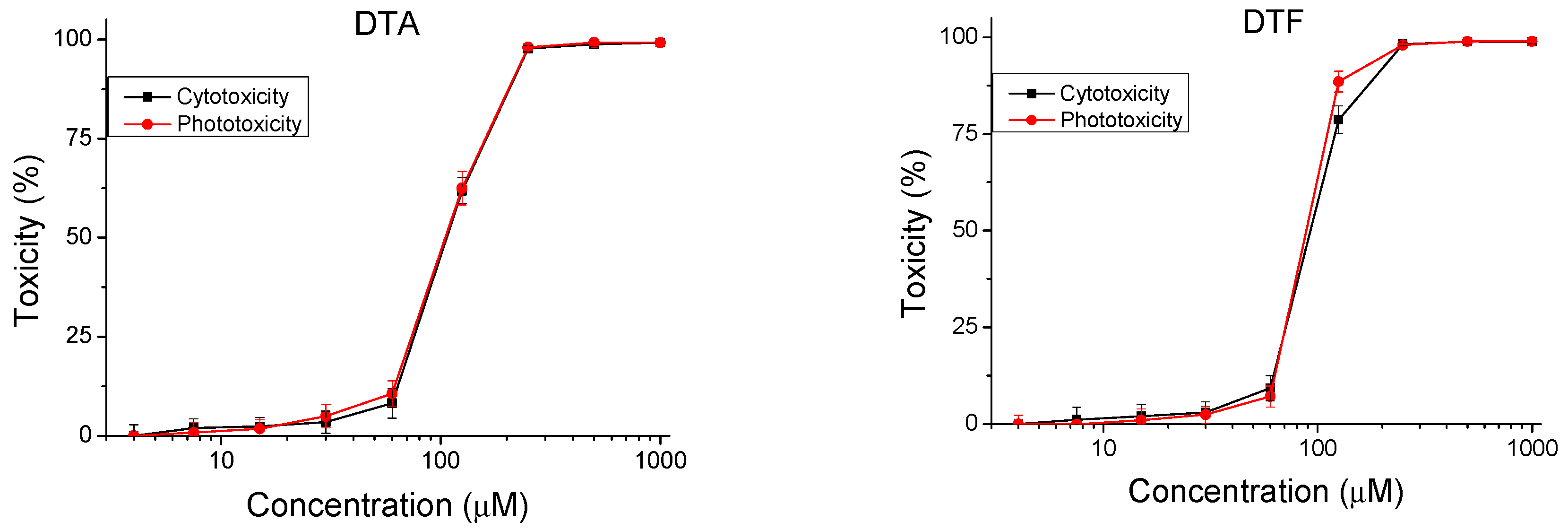

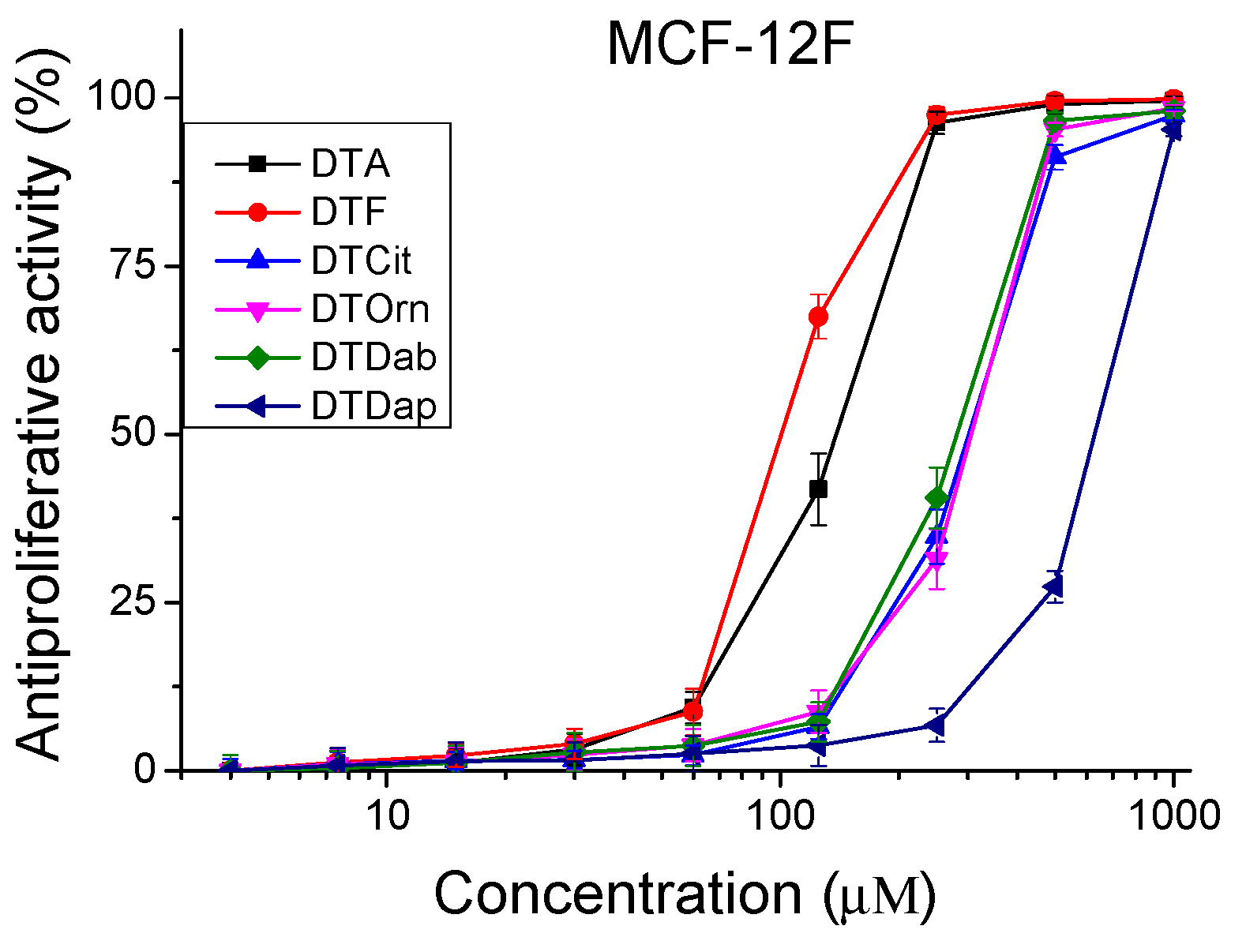

| Code | Structure | Molecular Formula | MM exact g/mol | [M+H]+ Observed g/mol | [M+Na]+ Observed g/mol | RT min | αD20 [°] * | M.p. [°C] |
|---|---|---|---|---|---|---|---|---|
| DTA | FLPLIG-R-VLSGIL-NH2 | C68H117N17O14 | 1395.90 | 1397.00 | 1418.95 | 4.513 | −38 | 158 ± 2 |
| DTF | FLPLIG-K-VLSGIL-NH2 | C68H117N15O14 | 1367.89 | 1368.80 | 1390.75 | 4.501 | −40 | 155 ± 3 |
| DTCit | FLPLIG-Cit-VLSGIL-NH2 | C68H116N16O15 | 1396.88 | 1397.75 | 1419.75 | 5.793 | −34 | 182 ± 2 |
| DTOrn | FLPLIG-Orn-VLSGIL-NH2 | C67H115N15O14 | 1353.87 | 1354.70 | 1376.70 | 4.364 | −42 | 123 ± 2 |
| DTDab | FLPLIG-Dab-VLSGIL-NH2 | C66H112N14O15 | 1340.84 | 1340.75 | 1362.70 | 4.191 | −52 | 138 ± 4 |
| DTDap | FLPLIG-Dap-VLSGIL-NH2 | C65H110N14O15 | 1326.83 | 1326.65 | 1348.70 | 4.077 | −48 | 140 ± 1 |
| Code | Mean CC50 ± SD (µM) | PIF * | |
|---|---|---|---|
| −Irr | +Irr | ||
| DTA | 106.32 ± 4.18 | 105.40 ± 4.88 | 1.01 |
| DTF | 92.40 ± 2.82 | 88.35 ± 1.48 | 1.05 |
| DTCit | 356.09 ± 7.64 | 331.78 ± 12.30 | 1.07 |
| DTOrn | 337.27 ± 7.09 | 345.1 ± 6.41 | 0.98 |
| DTDab | 209.57 ± 6.69 | 206.53 ± 7.41 | 1.01 |
| DTDap | 923.84 ± 21.56 | 933.3 ± 20.7 | 0.99 |
| Compounds | Mean IC50 ± SD (µM) | SI * | |||
|---|---|---|---|---|---|
| MCF-12F | MCF-7 | MDA-MB-231 | MCF-7 | MDA-MB-231 | |
| DTA | 138.65 ± 8.36 | 73.15 ± 3.36 | 115.13 ± 4.04 | 1.90 | 1.20 |
| DTF | 100.48 ± 3.30 | 49.75 ± 1.90 | 77.01 ± 2.92 | 2.02 | 1.30 |
| DTCit | 300.73 ± 10.49 | 149.69 ± 6.94 | 334.9 ± 4.37 | 2.01 | 0.90 |
| DTOrn | 305.59 ± 10.75 | 195.62 ± 3.63 | 302.87 ± 8.67 | 1.56 | 1.01 |
| DTDab | 280.25 ± 13.59 | 157.45 ± 4.97 | 174.91 ± 1.35 | 1.78 | 1.60 |
| DTDap | 630.44 ± 9.97 | 472.61 ± 16.21 | 580.97 ± 17.50 | 1.33 | 1.09 |
| Code | Structure | B. subtilis 3562 | E. coli 8785 | A. oxydans 9333 | P. aeruginosa 3700 | C. albicans 74 | Chloramphenicol [30 µg/disk] | Itraconazole [10 µg/disk] |
|---|---|---|---|---|---|---|---|---|
| B. subtilis 3562 | C. albicans 74 | |||||||
| DTA | FLPLIG-R-VLSGIL-NH2 | 8.8 ± 0.3 | 0.0 | 6.8 ± 0.3 | 7.8 ± 0.3 | 0.0 | 26.0 | 15.0 |
| DTF | FLPLIG-K-VLSGIL-NH2 | 8.5 ± 0.5 | 0.0 | 6.7 ± 0.3 | 7.0 ± 0.5 | 0.0 | 25.0 | 15.0 |
| DTCit | FLPLIG-Cit-VLSGIL-NH2 | 0.0 | 0.0 | 0.0 | 0.0 | 0.0 | 25.0 | 14.0 |
| DTOrn | FLPLIG-Orn-VLSGIL-NH2 | 0.0 | 0.0 | 0.0 | 0.0 | 0.0 | 25.0 | 15.0 |
| DTDab | FLPLIG-Dab-VLSGIL-NH2 | 0.0 | 0.0 | 8.2 ± 0.3 | 7.7 ± 0.6 | 0.0 | 25.0 | 14.0 |
| DTDap | FLPLIG-Dap-VLSGIL-NH2 | 0.0 | 0.0 | 0.0 | 0.0 | 0.0 | 26.0 | 14.0 |
| Gentamicin [10 µg/disk] | |||||||||
|---|---|---|---|---|---|---|---|---|---|
| Code | Structure | B. subtilis 3562 | E. coli 8785 | A. oxydans 9333 | P. aeruginosa 3700 | C. albicans 74 | E. coli 8785 | A. oxydans 9333 | P. aeruginosa 3700 |
| DTA | FLPLIG-R-VLSGIL-NH2 | 8.8 ± 0.8 | 0.0 | 9.7 ± 0.6 | 9.3 ± 0.6 | 0.0 | 18.0 | 18.0 | 17.0 |
| DTF | FLPLIG-K-VLSGIL-NH2 | 12.7 ± 0.6 | 0.0 | 11.5 ± 0.5 | 10.3 ± 0.8 | 0.0 | 18.0 | 20.0 | 16.0 |
| DTCit | FLPLIG-Cit-VLSGIL-NH2 | 0.0 | 0.0 | 0.0 | 0.0 | 0.0 | 18.0 | 19.0 | 16.0 |
| DTOrn | FLPLIG-Orn-VLSGIL-NH2 | 8.2 ± 0.3 | 0.0 | 8.3 ± 0.6 | 11.3 ± 0.6 | 0.0 | 18.0 | 19.0 | 16.0 |
| DTDab | FLPLIG-Dab-VLSGIL-NH2 | 11.3 ± 0.6 | 0.0 | 14.5 ± 0.5 | 14.3 ± 0.6 | 0.0 | 18.0 | 19.0 | 16.0 |
| DTDap | FLPLIG-Dap-VLSGIL-NH2 | 0.0 | 0.0 | 9.8 ± 0.3 | 8.8 ± 0.8 | 0.0 | 18.0 | 18.5 | 17.0 |
| Scheme of Experiment |  | Positions 1–3: 1.4 mg/mL Positions 4–6: 10 mg/mL AB: Antibiotic C: Control (10% EtOH/H2O) | |||
|---|---|---|---|---|---|
| B. subtilis 3562 | E. coli 8785 | A. oxydans 9333 | P. aeruginosa 3700 | C. albicans 74 | |
| DTA | 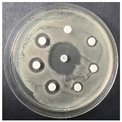 |  | 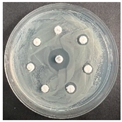 | 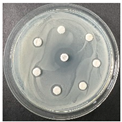 | 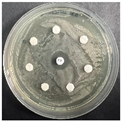 |
| DTF |  |  | 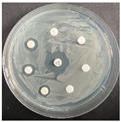 | 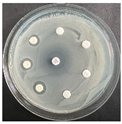 | 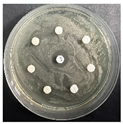 |
| DTCit | 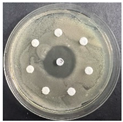 |  | 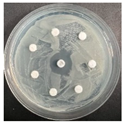 | 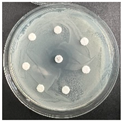 | 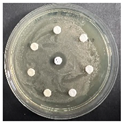 |
| DTOrn | 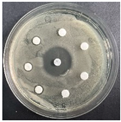 |  | 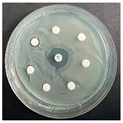 |  | 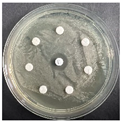 |
| DTDab | 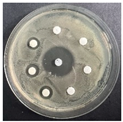 | 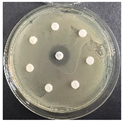 | 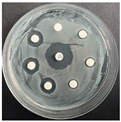 | 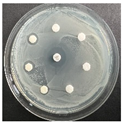 |  |
| DTDap | 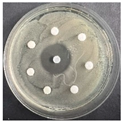 | 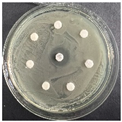 | 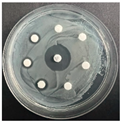 | 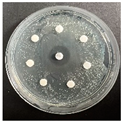 | 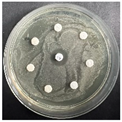 |
| Strain | B. subtilis 3562 | A. oxydans 9333 | P. aeruginosa 3700 | ||||
|---|---|---|---|---|---|---|---|
| Concentration | 1.4 mg/mL | 10 mg/mL | 1.4 mg/mL | 10 mg/mL | 1.4 mg/mL | 10 mg/mL | |
| Code | |||||||
| DTA | 33.8 | 33.8 | 37.8 | 53.9 | 45.9 | 54.7 | |
| DTF | 34.0 | 50.8 | 33.5 | 57.5 | 43.8 | 64.4 | |
| DTCit | 0.0 | 0.0 | 0.0 | 0.0 | 0.0 | 0.0 | |
| DTOrn | 0.0 | 32.8 | 0.0 | 43.7 | 0.0 | 70.6 | |
| DTDab | 0.0 | 45.2 | 43.2 | 76.3 | 48.1 | 89.4 | |
| DTDap | 0.0 | 0.0 | 0.0 | 53.0 | 0.0 | 51.8 | |
| Code | Structure | B. subtilis 3562 | E. coli 8785 | A. oxydans 9333 | P. aeruginosa 3700 | C. albicans 74 |
|---|---|---|---|---|---|---|
| DTA | FLPLIG-R-VLSGIL-NH2 | 80 µg/mL | 320 µg/mL | 80 µg/mL | 320 µg/mL | 320 µg/mL |
| DTF | FLPLIG-K-VLSGIL-NH2 | 80 µg/mL | 320 µg/mL | 80 µg/mL | 160 µg/mL | 320 µg/mL |
| DTCit | FLPLIG-Cit-VLSGIL-NH2 | NI | NI | 160 µg/mL | NI | NI |
| DTOrn | FLPLIG-Orn-VLSGIL-NH2 | 160 µg/mL | NI | 160 µg/mL | NI | NI |
| DTDab | FLPLIG-Dab-VLSGIL-NH2 | 160 µg/mL | 320 µg/mL | 320 µg/mL | 320 µg/mL | NI |
| DTDap | FLPLIG-Dap-VLSGIL-NH2 | 320 µg/mL | NI | NI | NI | NI |
Disclaimer/Publisher’s Note: The statements, opinions and data contained in all publications are solely those of the individual author(s) and contributor(s) and not of MDPI and/or the editor(s). MDPI and/or the editor(s) disclaim responsibility for any injury to people or property resulting from any ideas, methods, instructions or products referred to in the content. |
© 2024 by the authors. Licensee MDPI, Basel, Switzerland. This article is an open access article distributed under the terms and conditions of the Creative Commons Attribution (CC BY) license (https://creativecommons.org/licenses/by/4.0/).
Share and Cite
Dimitrova, D.; Nemska, V.; Foteva, T.; Iliev, I.; Georgieva, N.; Danalev, D. Synthesis and Biological Studies of New Temporin A Analogs Containing Unnatural Amino Acids in Position 7. Pharmaceutics 2024, 16, 716. https://doi.org/10.3390/pharmaceutics16060716
Dimitrova D, Nemska V, Foteva T, Iliev I, Georgieva N, Danalev D. Synthesis and Biological Studies of New Temporin A Analogs Containing Unnatural Amino Acids in Position 7. Pharmaceutics. 2024; 16(6):716. https://doi.org/10.3390/pharmaceutics16060716
Chicago/Turabian StyleDimitrova, Dilyana, Veronica Nemska, Tsvetelina Foteva, Ivan Iliev, Nelly Georgieva, and Dancho Danalev. 2024. "Synthesis and Biological Studies of New Temporin A Analogs Containing Unnatural Amino Acids in Position 7" Pharmaceutics 16, no. 6: 716. https://doi.org/10.3390/pharmaceutics16060716








